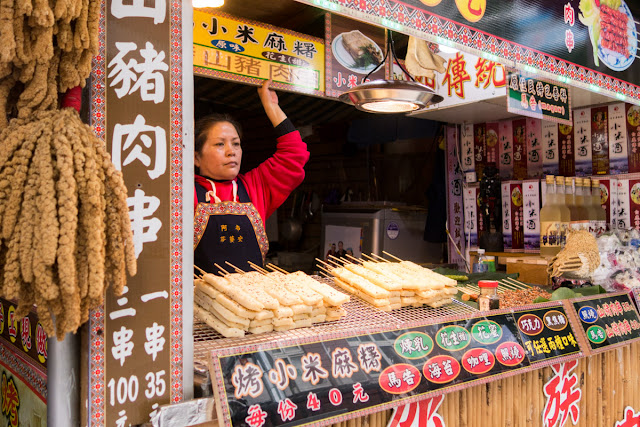 |
| Checheng (車埕) on a misty morning - our first stop on our Jiji line day trip (集集線一日遊). |
One of the things that really stood out in Taiwan was the hospitality we experienced here. In Puli (埔里), our guesthouse is run by a husband-and-wife team. The husband has a day job aside from the guesthouse business, and he would drop us off at convenient spots on his way to work in the early mornings, to help give us a kick-start to our sight-seeing!
In fact, it is thanks to him that we even discovered the magic of the Jiji railway line (集集線) at all. After a day at Sun Moon Lake, we had another day free to do whatever we wanted, and he enthusiastically suggested that we should check out the little towns and villages along the Jiji line. "You'll get to see the Taiwan of 40 years ago," he said.
 |
| Not sure where this picture was taken... possibly either Yuanquan (源泉), Zhuoshui (濁水) or Longquan (龍泉). |
As you may know, I am a nostalgic person at heart, and have a soft spot for the old-school stuff, so that totally sold me. I can say that I'm so happy we took his advice - our adventures exploring the gorgeous little rural townships along the Jiji line was one of the best bits of our Taiwan trip!
Also, during one of our train rides, we met two friendly Indonesian guys, who were picking betel nuts for a living. We had a nice chat with them, and shared a giggle about how scantily clad the betel nut beauties can be in Taiwan!
 |
| A couple of cats hanging out at Jiji Station (集集車站). |
I have to admit that some of the places we visited kind of just blurred together for me. It takes some random luck, I think - I'm sure every town has their interesting aspects, but you don't always find them unless you know where to go!
 |
| A household/hardware shop in Shuili Township (水里鄉). |
One place I do remember very well, however, is Ershui. We spent the most time there, and I certainly took more photos there than anywhere else that day.
 |
| Ershui Township (二水鄉) in Changhua County (彰化縣). |
Here, you see charming little shops that really do look like they probably haven't changed much in several decades. I can't help but wonder if this old man has been running this business since he was a young chap. Imagine!
 |
| A traditional Chinese medicine shop in Ershui Township (二水鄉). |
The look and feel of the architecture here totally brings me back to my childhood.
 |
| A sweet blue shop/house in Ershui. |
Completely by accident, we stumbled upon this fabulously quaint residential area with the cutest, tiniest houses ever. Look how they're only a little bit taller than Simon! It was pure delight. If I didn't already adore Ershui before, I was definitely totally in love at this point.
 |
| The most adorable tiny houses in Ershui. |
Then, after a few more twist and turns...
 |
| A cool alleyway. |
We found this century-old soy sauce factory, which our guesthouse host had told us about. I was very pleased that we managed to track it down!
 |
| The old San Yi-Quan soy sauce shop (三義泉和德醬油店) in Ershui. |
This soy sauce business has been running for at least three generations, and they still use the traditional method of fermenting the soy sauce in earthen vats under the warmth of the sun in the middle of their courtyard. This brewing process can take up to six months to complete. They only open one vat each month, and each vat yields about twenty bottles of soy sauce, so this is precious commodity. I would have loved to purchase a bottle while we were there, but alas, they didn't seem to be open that day. I was glad that we got a glimpse of their operations, at least!
 |
| Brewing/fermenting soy sauce the traditional way. |
After our stroll around town, we stopped by a restaurant to grab some lunch.
 |
| We actually ate at the little shop on the side with the blue and white covers (阿明火燒麵隔壁的店). |
The menu had items such as tofu soup for as cheap as 10 NTD, and the most expensive thing was still only 40 NTD for a century egg tofu dish.
 |
| The menu had cheap and cheerful fare. |
Simon had the minced pork rice, which was not bad at all.
 |
| Minced pork rice (肉燥饭), 25 NTD. |
And I was happy with my short rice noodle soup.
 |
| Short and thick rice noodles in a soup (米苔目), 25 NTD. |
Without a question, our Jiji line expedition surpassed my expectations, and I couldn't have thought of a better way to spend a day - kudos to our guesthouse host for this wonderful recommendation! The charms of bygone eras are evident on this great little railway route - I truly felt like I'd gone back in time during this journey. So if you're ever in central Taiwan, seriously consider checking out the Jiji railway line and its stops - truly, there are hidden gems lying within worth uncovering.
 |
| Traversing the streets of Ershui. |
Click here to read the rest of the post!










































